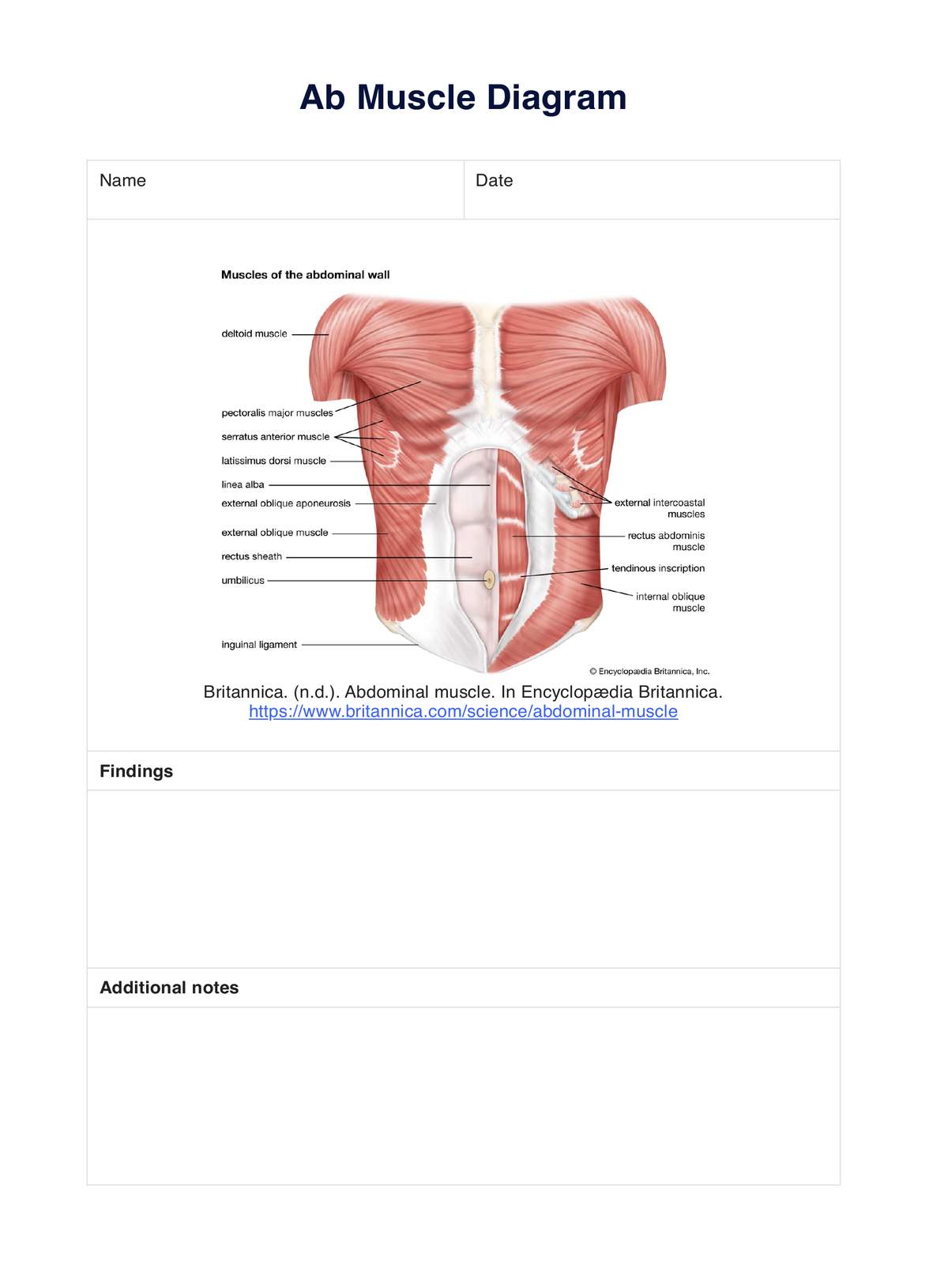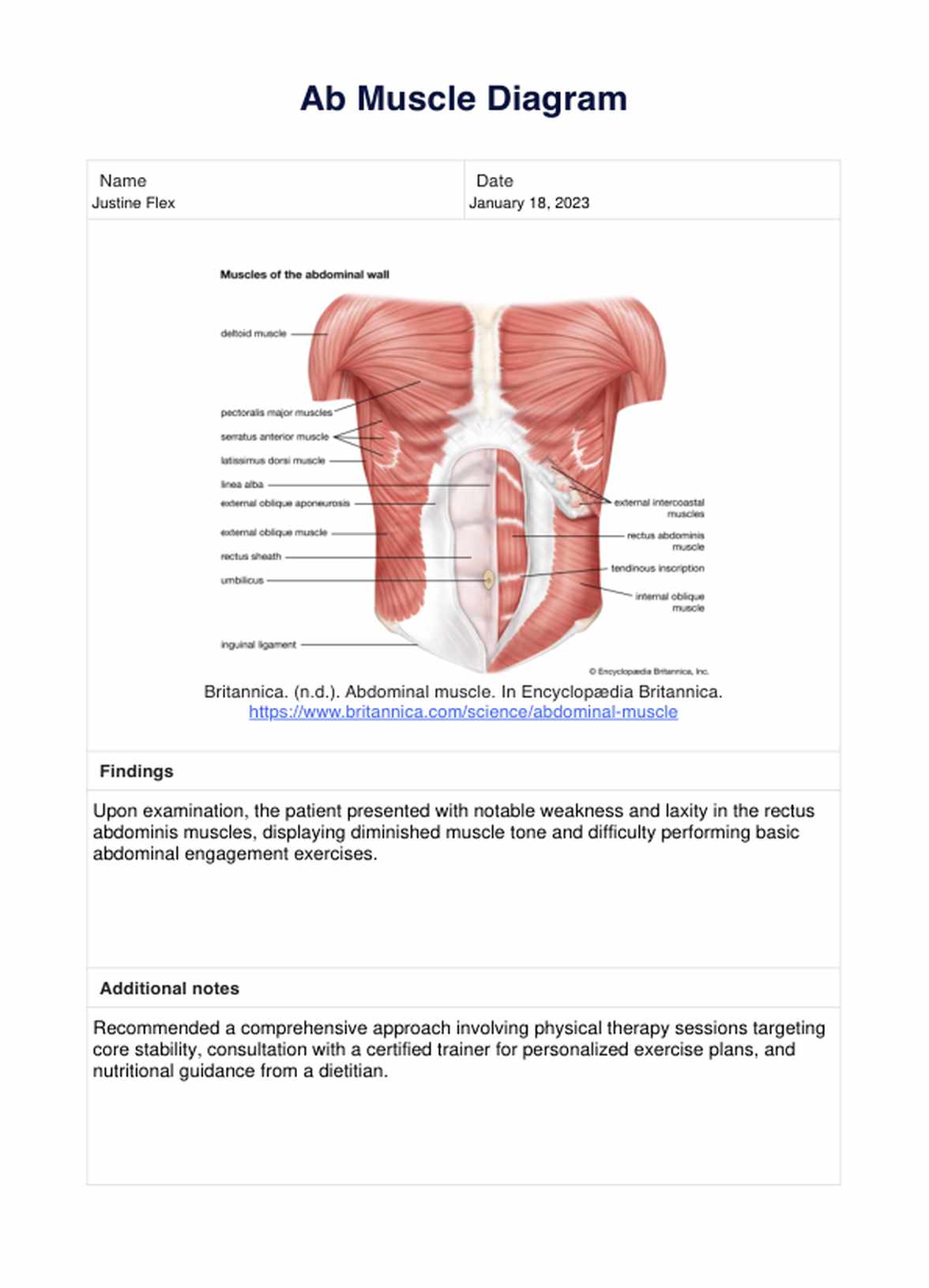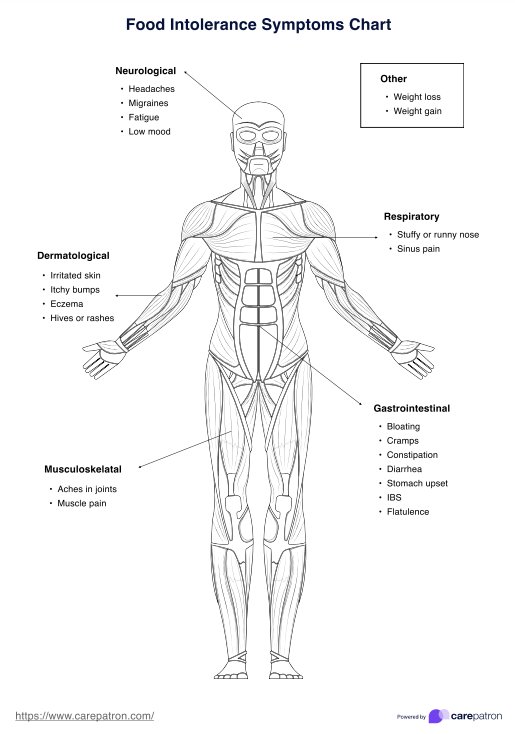Ab Muscle Diagram
Get a free Ab Muscle Diagram for your practice. Learn more about the ab's vital parts and functions in this guide.


What is an Ab Muscle Diagram?
An Ab Muscle Diagram visualizes the abdominal muscles, constituting the front of the body's trunk between the thorax (chest) and the pelvis.
This diagram typically includes major muscles like rectus abdominis, known for the 'six-pack' look; transverse abdominis, the deepest muscle that provides stability and compresses the abdomen; and the internal and external obliques, which help in side bending and waist twisting movements. These muscles collectively support the spine, assist in breathing, and enable movements such as bending and twisting. They also play a crucial role in protecting internal organs.
Healthcare professionals may use the diagram as a visual aid to explain the location and functions of these muscles to patients. It can also help better explain medical findings, such as muscle strains or hernias, and recommend exercises for strengthening the abdominal muscles. By understanding the anatomy of their abdominal muscles, patients can also better understand why specific exercises benefit their overall health and well-being.
Ab Muscle Diagram Template
Ab Muscle Diagram Example
How does it work?
Carepatron's free Ab Muscle Diagram allows you to easily explain its various parts, including the oblique muscle, rectus abdominis, and transverse abdominis. Here's how to use the template:
Step 1: Download the diagram
Get a copy of the printable Ab Muscle Diagram using the link on this page. You may access it from the Carepatron app or our practice management solution resources library.
Step 2: Explain it to your patient
While showing the diagram to your patient, you can explain the functions of each muscle and how they work together. You can also use it to show any areas of concern or injury, such as a strained muscle or a hernia.
Step 3: Note down any findings
You can also use the template to document any medical findings related to the abdominal muscles. This can include muscle strains, hernias, or other issues affecting your patient's health and well-being.
Step 4: Suggest exercises
Based on your patient's needs and medical condition, you can suggest specific exercises that target the abdominal muscles. These can include planks, crunches, and leg lifts. Patients can better understand how these exercises benefit their abdominal muscles by referencing the diagram.
When should you use this template?
Here are several instances where Careparon's printable Ab Muscle Diagram is valuable:
When discussing abdominal muscles with patients
Our Ab Muscle Diagram can help you visually explain the functions and structure of the abdominal muscles to your patients. This can be especially helpful when discussing any concerns or injuries related to these muscles.
When documenting medical findings
The template allows you to record any medical findings related to the abdominal muscles, making it easier for future reference and monitoring your patient's health.
During patient consultations or follow-up appointments
Using the Ab Muscle Diagram during consultations or follow-up appointments, you can better track your patient's progress and make any necessary adjustments to their treatment plan.
As a reference for suggesting exercises
Some patients may require exercises specifically targeting their abdominal muscles for rehabilitation or strengthening. The Ab Muscle Diagram can be a reference when suggesting appropriate exercises to target these specific muscles.
The ab muscle in details
The ab muscle, also known as the abdominal muscle, consists of four major muscles: rectus abdominis, external obliques, internal obliques, and transversus abdominis. Let's dive deeper and understand each muscle's functions:
Rectus abdominis
The rectus abdominis is commonly called the "six-pack" muscle due to its appearance in those with low body fat. It is a long, flat muscle that runs vertically from the pubic bone to the sternum. Its primary function is to flex the spine, but it also plays a role in stabilizing the pelvis and maintaining good posture.
External obliques
The external obliques are located on the sides of the abdomen and run diagonally from the lower ribs to the pelvis. They are responsible for rotating and bending the trunk and assisting in breathing. Strong external obliques can also help improve posture.
Internal obliques
The internal obliques lie underneath the external obliques and run in the opposite direction, from the pelvis to the lower ribs. They work together with the external obliques to rotate and bend the trunk, providing stability to the spine.
Transversus abdominis
The transversus abdominis is the deepest layer of abdominal muscle and stabilizes the spine during movement. It wraps around the torso like a corset, providing support and protection for the internal organs.
Ab muscle functions
The ab muscle provides stability and support to the spine and pelvis, allowing us to maintain good posture and move efficiently (Cleveland Clinic, 2021). It also plays a crucial role in protecting our internal organs and aiding digestion.
Strong ab muscles can improve overall physical performance, reducing the risk of injury during daily activities or sports. They also help prevent lower back pain (Harvard Health Publishing, n.d.) and improve balance and coordination (Better Health Channel, n.d.).
Additionally, the ab muscles play a crucial role in breathing. These muscles work together with the diaphragm to support proper breathing mechanics, allowing for a more efficient exchange of oxygen and carbon dioxide (Cleveland Clinic, 2021).
Not only do ab muscles have functional benefits, but they also contribute to our aesthetic appearance. Strong abs can help create a toned and defined midsection, which is generally sought after for both health and cosmetic reasons.
All in all, the functions of ab muscles go far beyond just a "six-pack" appearance. Strong abs are essential for overall health, stability, and physical performance. Therefore, regularly incorporating exercises that target these muscles into our fitness routines is crucial. Strength training and proper nutrition can help us achieve robust and healthy ab muscles.
References
Better Health Channel. (n.d.). Abdominal muscles. Better Health Victoria. https://www.betterhealth.vic.gov.au/health/conditionsandtreatments/abdominal-muscles
Cleveland Clinic. (2021). Abdominal muscles. https://my.clevelandclinic.org/health/body/21755-abdominal-muscles
Harvard Health Publishing. (n.d.). The real-world benefits of strengthening your core. Harvard Health Beat. https://www.health.harvard.edu/healthbeat/the-real-world-benefits-of-strengthening-your-core
Commonly asked questions
You can use the Ab Muscle Diagrams to learn about the different layers and functions of the abdominal muscles. These diagrams can also help you identify specific muscle groups and their roles in stabilizing the spine, supporting posture, and aiding in movement.
Ab Muscle Diagrams can be used in a clinical setting for patient education and communication. These diagrams can help medical professionals explain the anatomy of the abdominal muscles to patients, aiding in their understanding of their condition or treatment plan.
Yes! Carepatron's Ab Muscle Diagrams can be customized to fit your needs. Add sections, labels, and notes to make the diagrams more personalized for your specific learning goals.












































































































